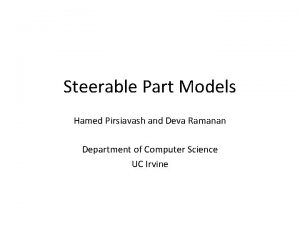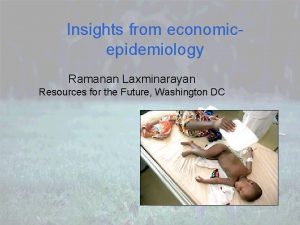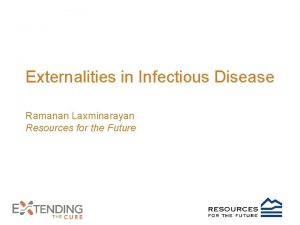Insights from economicepidemiology Ramanan Laxminarayan Resources for the









































- Slides: 41

Insights from economicepidemiology Ramanan Laxminarayan Resources for the Future, Washington DC

Economic Epidemiology Mathematical conceptualization of the interplay between economics, human behavior and disease ecology to improve our understanding of – the emergence, persistence and spread of infectious agents – optimal strategies and policies to control their spread

Economics Ø Measuring health outcomes Ø Provides a single metric to compare costs and benefits both contemporaneously and over time. Ø Incorporating behavior Ø Can alter conclusions reached by purely epidemiological models by incorporating behavior. Ø Comparing public policies Ø Increases relevance for application in the real world.

Overview n n n Individual response and disease Incentives of institutions (to invest in hospital infection control) Optimal allocation of resources between two regions (or hospitals)

Individual response and disease n Vaccinations – Insufficient incentives to vaccinate prevent attainment of herd immunity thresholds n Drug resistance – Insufficient incentives to make appropriate use leads to ineffective drugs and increasing prevalence n Testing – Private testing behavior adds to public information on disease prevalence

Rational epidemics n Prevalence response elasticity – Hazard rate into infection of susceptibles is a decreasing function of prevalence (opposite of epidemiological model predictions) – Application to HIV – Application to Measles

Geoffard and Philipson, Int. Econ. Rev. , 1996

Blower et al, Science, 2000

Blower et al, Science, 2000

When should governments intervene? n n n Disease prevalence increases adoption of public programs Impact of public program may be zero if prevalence has already reached an individual’s threshold prevalence Paradoxically, the role of government subsidies is lowest when prevalence is highest since individuals will protect themselves regardless

Philipson, NBER, 1999

Public price subsidies n Can price subsidies or mandatory programs achieve eradication? – Increase in demand by folks covered by the program lowers the incentives to vaccinate for those outside the program n Do monopolistic vaccine manufacturers have an incentive to eradicate disease? – Market for their product would disappear with eradication Geoffard and Philipson, Int Econ Rev, 1997


Disease Complementarities n n Incentive to invest in prevention against one cause of death depends positively on probability of dying from other causes Intervening to prevent mortality not only prevents a death but also increases incentives for the family to fight other diseases

Dow et al, Am Econ Rev, 1999

Does theory fit the facts? n n n Do individuals actually observe prevalence? Why don’t we see prevalence responsiveness at work everywhere? Importance of observational learning (herd behavior)?

Stoneburner and Low-Beer, Science, 2004

Stoneburner and Low-Beer, Science, 2004

Stoneburner and Low-Beer, Science, 2004

NNIS Data, 2004

Optimal infection control Infection dynamics are given by Equilibrium prevalence is given by Smith, Levin, Laxminarayan (PNAS, 2005)

Objective Minimize costs of infection control and infections Local minima, if they exist, are solutions to Smith, Levin, Laxminarayan (PNAS, 2005)

Smith, Levin, Laxminarayan (PNAS, 2005)

Strategic interactions with other hospitals The focal institution decides how much to invest in HIC by minimizing the net present value of discounted costs of HIC and hospitalization: Smith, Levin, Laxminarayan (PNAS, 2005)




Implications for policy n n Dutch experience: frequency of MRSA infections is < 0. 5% after an intensive ‘‘search -and-destroy’’ campaign, compared with 50% in some areas In Siouxland (Iowa, Nebraska, S. Dakota), an epidemic of VRE was reversed Regionally coordinated response to epidemic Does this explain higher prevalence of ARB in areas with high concentration of health care institutions?

Rowthorn, Laxminarayan, Gilligan Submitted

Rowthorn, Laxminarayan, Gilligan Submitted

Rowthorn, Laxminarayan, Gilligan Submitted

Rowthorn, Laxminarayan, Gilligan Submitted

Allocating resources Expenditure on drugs is subject to the budget constraint Finance is not transferable through time. Problem is to choose F₁and F₂ so as to minimise the following integral Rowthorn, Laxminarayan, Gilligan Submitted

Optimal allocation n At low levels of infection in both populations – Preferentially treat population with higher transmission coefficient because of greater economic value associated with greater potential to prevent secondary infections n At high levels of infection – Preferentially treat population with lower levels of infection since the higher probability of re-infection in high infection populations reduces the economic value of treatment Rowthorn, Laxminarayan, Gilligan Submitted

Rowthorn, Laxminarayan, Gilligan Submitted






Closing thoughts n n Epidemiological models take little or no account of economic constraints or incentives faced by individuals or institutions Economic models mostly ignore the spatial and temporal dynamics of disease.
 Deva ramanan
Deva ramanan Difference between fixed and variable resources
Difference between fixed and variable resources Renewable resources vs nonrenewable resources
Renewable resources vs nonrenewable resources What is the transformative process of operations management
What is the transformative process of operations management Delegerande ledarskap
Delegerande ledarskap Indikation för kejsarsnitt på moderns önskan
Indikation för kejsarsnitt på moderns önskan Toppslätskivling dos
Toppslätskivling dos Redogör för vad psykologi är
Redogör för vad psykologi är Ramsa geometriska former
Ramsa geometriska former Claes martinsson
Claes martinsson En lathund för arbete med kontinuitetshantering
En lathund för arbete med kontinuitetshantering Mat för unga idrottare
Mat för unga idrottare Etik och ledarskap etisk kod för chefer
Etik och ledarskap etisk kod för chefer Offentlig förvaltning
Offentlig förvaltning Skriven med rytm och rim
Skriven med rytm och rim Vad kallas den mantel som bars av kvinnor i antikens rom
Vad kallas den mantel som bars av kvinnor i antikens rom Orubbliga rättigheter
Orubbliga rättigheter Steg för steg rita
Steg för steg rita Densitet vatten
Densitet vatten Ministerstyre för och nackdelar
Ministerstyre för och nackdelar Big brother rösta
Big brother rösta Kanaans land
Kanaans land Nationell inriktning för artificiell intelligens
Nationell inriktning för artificiell intelligens Tillitsbaserad ledning
Tillitsbaserad ledning Nyckelkompetenser för livslångt lärande
Nyckelkompetenser för livslångt lärande Ro i rom pax
Ro i rom pax Modell för handledningsprocess
Modell för handledningsprocess Stål för stötfångarsystem
Stål för stötfångarsystem Adressändring ideell förening
Adressändring ideell förening Verktyg för automatisering av utbetalningar
Verktyg för automatisering av utbetalningar Shivaismen
Shivaismen Cks
Cks Vad är hsil
Vad är hsil Jag har nigit för nymånens skära text
Jag har nigit för nymånens skära text Strategi för svensk viltförvaltning
Strategi för svensk viltförvaltning Stig kerman
Stig kerman Verksamhetsanalys exempel
Verksamhetsanalys exempel Formel standardavvikelse
Formel standardavvikelse Datorkunskap för nybörjare
Datorkunskap för nybörjare Tack för att ni har lyssnat
Tack för att ni har lyssnat Klassificeringsstruktur för kommunala verksamheter
Klassificeringsstruktur för kommunala verksamheter Returpilarna
Returpilarna
































































